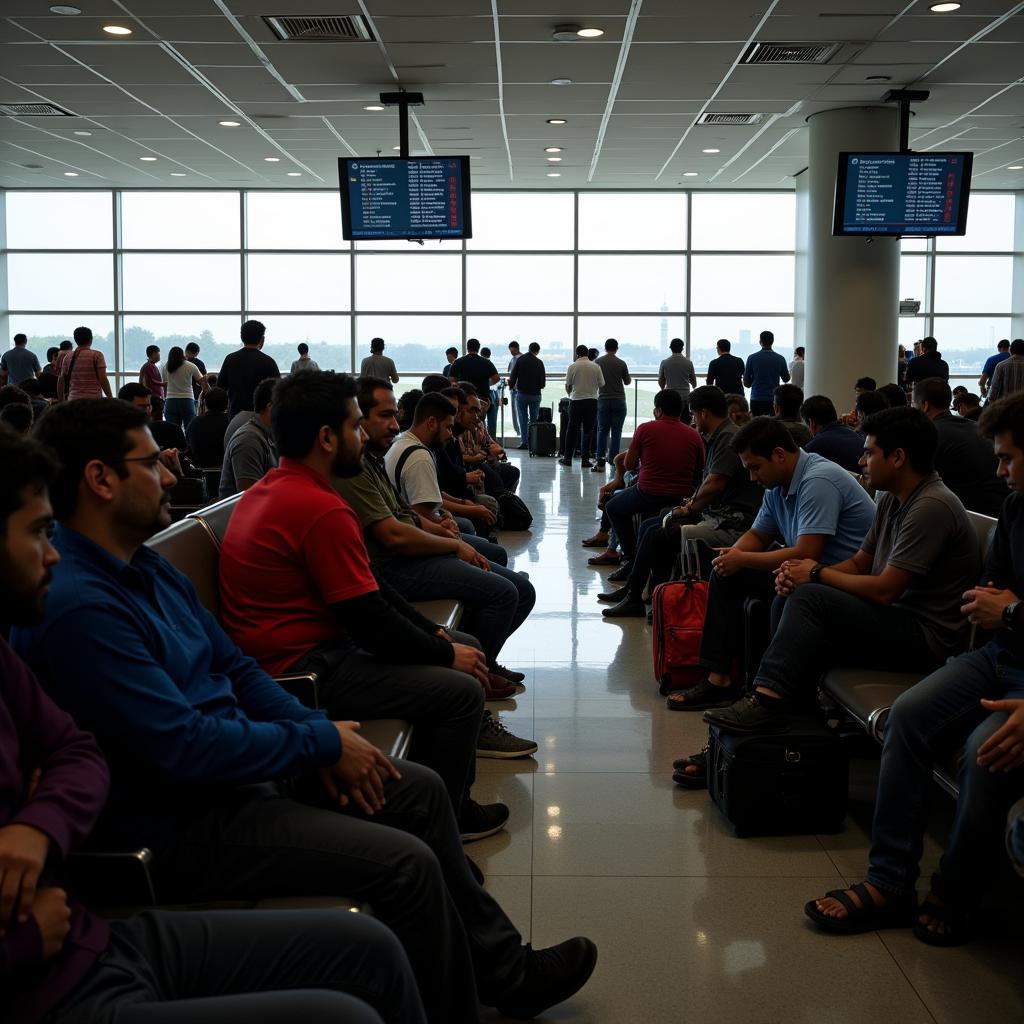Ahmedabad Airport Flooded in July 2022, causing significant disruption to air travel and raising concerns about the airport’s vulnerability to extreme weather. This article explores the causes and consequences of the flooding, the airport’s response, and the broader implications for airport infrastructure in the face of climate change. We’ll also delve into the recovery efforts and what passengers need to know when traveling through Ahmedabad Airport.
The Deluge: How Ahmedabad Airport Became Submerged
The 2022 flooding at Sardar Vallabhbhai Patel International Airport (AMD) was a stark reminder of the increasing impact of extreme weather events. Record monsoon rainfall overwhelmed the airport’s drainage systems, leading to widespread inundation across the airfield and terminal buildings. The flooding impacted flight operations, stranded passengers, and caused damage to airport infrastructure. The event highlighted the need for robust disaster preparedness and resilient infrastructure.
While the immediate trigger was heavy rainfall, several contributing factors exacerbated the situation. These included inadequate drainage capacity, the airport’s geographical location in a low-lying area, and potential blockages in existing drainage channels. The incident underscored the vulnerability of airports, which are often located in coastal or low-lying areas, to the impacts of climate change, including rising sea levels and more frequent and intense rainfall.
 Ahmedabad Airport Flooded in July 2022
Ahmedabad Airport Flooded in July 2022
Impact on Operations and Passengers: The Ripple Effect of the Flood
The Ahmedabad airport flooded situation had a cascading impact on both airport operations and passenger experience. Numerous flights were delayed or canceled, stranding thousands of passengers. The flooding also disrupted baggage handling and other essential airport services. The airport authorities worked tirelessly to manage the crisis, providing temporary accommodation and assistance to stranded passengers.
The financial implications of the flood were also significant, with airlines incurring losses due to flight disruptions and the airport facing costs associated with repairs and recovery. The incident served as a wake-up call for the aviation industry, emphasizing the importance of investing in resilient infrastructure and developing effective contingency plans.
What happened when Ahmedabad airport flooded? Chaos, primarily.
 Passengers Stranded at Ahmedabad Airport due to Flooding
Passengers Stranded at Ahmedabad Airport due to Flooding
Recovering from the Deluge: Ahmedabad Airport’s Response and Future Preparedness
In the immediate aftermath of the flood, the airport authorities initiated a comprehensive recovery effort. This involved clearing the floodwaters, assessing the damage to infrastructure, and restoring essential services. The airport worked closely with airlines and other stakeholders to resume normal operations as quickly as possible.
Beyond the immediate response, the flooding prompted a reassessment of the airport’s vulnerability to extreme weather. The airport has since undertaken measures to enhance its drainage systems, improve its emergency preparedness plans, and incorporate climate resilience into future infrastructure development.
According to aviation expert, Dr. Anjali Sharma, “The Ahmedabad airport flooding incident highlighted the crucial need for airports to proactively adapt to the changing climate. Investing in robust infrastructure and developing effective contingency plans are vital for ensuring the continued safety and efficiency of air travel.”
Lessons Learned: Strengthening Airport Resilience in a Changing Climate
The experience of Ahmedabad airport flooded offers valuable lessons for airports worldwide. It underscores the increasing importance of incorporating climate resilience into airport planning and design. As extreme weather events become more frequent and intense, airports must invest in robust infrastructure, develop effective drainage systems, and implement comprehensive emergency preparedness plans.
Furthermore, the incident highlights the need for improved coordination between airports, airlines, and other stakeholders in responding to such crises. Effective communication, efficient resource allocation, and a coordinated approach are essential for minimizing the impact of extreme weather on airport operations and passenger experience.
Mr. Rohan Mehta, a senior airport consultant, adds, “The key takeaway from the Ahmedabad flooding is that proactive planning and investment in climate resilience are no longer optional but essential for ensuring the long-term viability of airport infrastructure.”
Conclusion: Navigating the Future of Air Travel in a Changing Climate
The Ahmedabad airport flooded incident serves as a stark reminder of the challenges posed by climate change to the aviation industry. As extreme weather events become more frequent, airports must prioritize climate resilience to ensure the safety and efficiency of air travel. By learning from the experience of Ahmedabad and other airports, the aviation industry can proactively adapt to the changing climate and build a more resilient future for air travel.
FAQ
- Was Ahmedabad airport flooded recently? Yes, Ahmedabad airport experienced significant flooding in July 2022 due to heavy monsoon rains.
- What caused the flooding at Ahmedabad airport? The flooding was primarily caused by record rainfall that overwhelmed the airport’s drainage systems, coupled with its location in a low-lying area.
- How did the flooding impact passengers? Thousands of passengers were stranded due to flight cancellations and delays. The airport provided temporary accommodation and assistance to affected travelers.
- What measures has the airport taken to prevent future flooding? The airport has undertaken measures to enhance its drainage systems, improve emergency preparedness, and incorporate climate resilience into future development.
- Is it safe to travel through Ahmedabad airport now? Yes, the airport has restored normal operations and implemented measures to mitigate the risk of future flooding.
- What should passengers do if they encounter travel disruptions due to weather? Passengers should contact their airline for information about flight status and rebooking options. They should also monitor airport websites and social media channels for updates.
7.. What are the long-term implications of this event? The flooding highlighted the need for airports globally to prioritize climate resilience in their infrastructure and operations.
Need More Assistance?
For further support regarding Ahmedabad airport or any other travel inquiries, please contact us:
Phone: +13089626264
Email: [email protected]
Address: 404 Bothwell St, Oxford, NE 68967, USA
Our customer service team is available 24/7 to assist you. We also have articles about other airport related topics on our website. Check them out!

